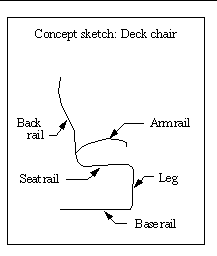E MCH 13 Design Project: Chair
9 February 1998
Problem
 Design a lightweight
deck chair having simple, but elegant lines. Key specifications:
Design a lightweight
deck chair having simple, but elegant lines. Key specifications:
- Dimensions and strength to accommodate the 95 percentile range of the U.S. male population as determined by standard anthropometric data.
- Shaped ergonomically for comfort.
- Components will ship disassembled and assemble easily using pliers and a screwdriver by a customer with little mechanical inclination.
- Design for mild impact: Assume the standard occupant drops from a height of zero above the seat (see Hibbeler (1997), § 14.4, Eq. 14.34 in particular).
- As a precaution against material yielding, set the factor of safety (FS) to 1.3.
- Finish base rail to prevent marring floors and slipping.
Design objective
The design objectives are light weight and minimum cost in that order. Hence a figure of merit equal to the weight of the chair in pounds multiplied by the cost in dollars is to be reported. Costs are to be determined using nominal retail prices.
Special concerns
- Consider that chairs may be subjected to unorthodox treatment. For instance, it would be wise to design the arm of the chair to support somewhat more force than that applied when leaning on the arms to sit or rise.
- The chair should be well balanced. In particular, it should be difficult to tip it over backwards from a sitting position.
Report
The design will be done in U.S. Customary Units. Follow the "Design Project Report Format for E Mch 013 with Design".
References
Hibbeler, R.C. (1997) Mechanics of Materials, Prentice Hall, Englewood Cliffs.
Roark, Raymond J. and W. C. Young (1975) Formulas for Stress and Strain, McGraw-Hill Book Co., New York, Table 37. Formulas of stress concentration for elastic stress.
Salvendy, Gavriel (1997) Handbook of Human Factors and Ergonomics, John Wiley & Sons, Inc., New York.
This material is based upon work supported by the National Science Foundation under Grant No. 0633602. Any opinions, findings and conclusions or recomendations expressed in this material are those of the author(s) and do not necessarily reflect the views of the National Science Foundation (NSF).
© Copyright 1995-2024 — All rights reserved.
Pennsylvania State University
Department of Engineering Science and Mechanics
Send comments about this site to: webmaster@esm.psu.edu
This publication is available on alternative media on request.
